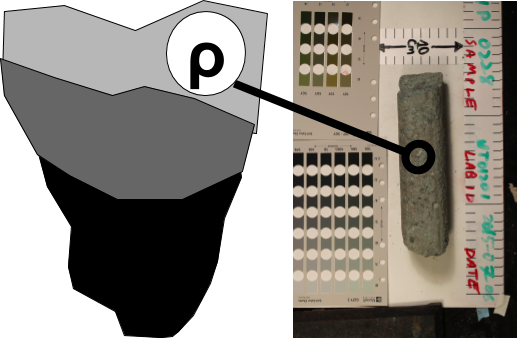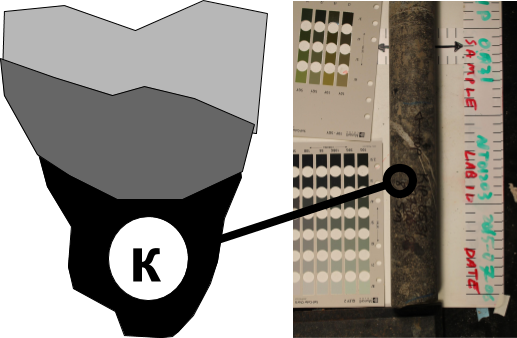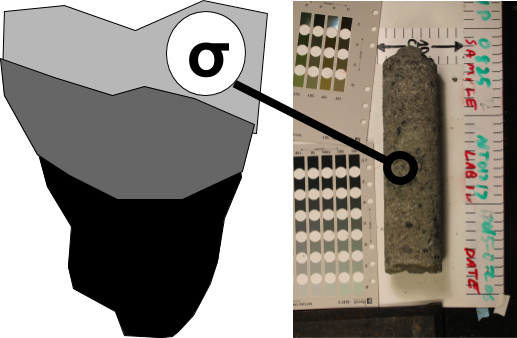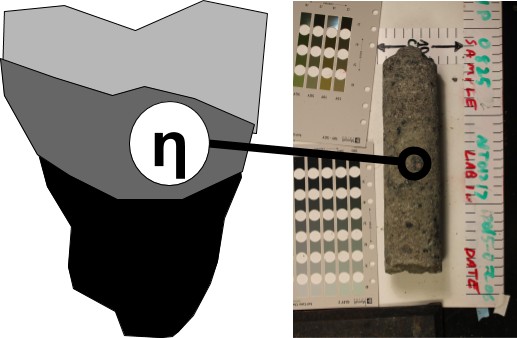
Properties
A common geophysical fingerprint for a kimberlite pipe near the poles is a circular strong magnetic anomaly, with a gravitational low and an anomalous EM response. The composition of the kimberlite pipes exhibits different physical properties than those of the host rock and forms the basis for a geophysical exploration model.
Density

Kimberlite pipes are generally associated with negative gravity anomalies due to their low density, although some exceptions exist [RW07]. In the Lac de Gras region, pyroclastic units (PK) are highly variable in composition, but are often made up of a mix of fine grain volcaniclastic sediments (tuff, lapilli) and larger xenoliths of country rock. Fragments of wood, shale, siltstone and mudstone clasts are common depending on the style of eruption and depositional environment [Pel97]. Moreover, olivine-rich volcaniclastic sediments are readily altered to clay minerals through low-temperature metamorphism, further contributing to lower the density [Mas99]. Overall, we expect the density of kimberlite pipes to be less than that of the background granitic rock.
Susceptibility

The bulk magnetic susceptibility of kimberlite rocks is highly variable and depends largely on the concentration and size of magnetite grains. Intrusive rocks, such as HK and VK units, tend to have a stronger magnetic signature than the host rock and PK kimberlite [PH07] [RW07]. In addition, there has been many documented cases of kimberlite pipes with strong remanent magnetization [Cla83] [Mac85] [Har89] [KS04]. At high latitude, such as in the Lac de Gras region, remanence is clearly identified by the reverse (-) polarity of the field. Therefore, we expect the susceptibility of kimberlite pipes to be higher than that of the background granitic rock, but we must be aware that the response may not by purely induced.
Conductivity

Electrical conduction is relevant to understanding of the geology of kimberlites through a number of routes. First, many kimberlite pipes are filled with olivine-rich volcaniclastic sediments [Mas99] and generally serpentinized through low-temperature metamorphism. Further weathering in the upper region of the kimberlite pipes alters the rock to clay minerals which are conductive compared to the host rocks. Secondly, glacial scouring of the low competency kimberlitic rocks often results in the thick accumulation of glacial till and lake sediments, which are typically conductive. The Lac de Gras region is located in a sub-Arctic region with a documented permafrost layer of variable thickness [GolderALtd14]. Laboratory and field measurements have shown strong dependencies between temperature and the EM response.
Chargeability

From the perspective of kimberlite exploration, little has been done in the past to use chargeability as a diagnostic physical property. Ice and near- surface clays are known to be chargeable. The temperature dependence of conductivity [GS15] and the presence of ice, as well as fine glaciofluvial sediments, can be the sources of chargeability. The resulting IP signal is often considered as “noise” that impedes the interpretation of EM data and it is commonly referred to as IP contamination [KA12]. Recent studies, however, have shown that negative transients in time-domain EM data could be attributed to more interesting geological features [EKE04] [FPO09] [KM12] [KOYM14]. In this study, we will attempt to extract chargeability information from the EM data to characterize the kimberlite rocks.
Conceptual model
In summary, we have four physical properties which could be diagnostic in differentiating between kimberlites and host rock, as well as between the different kimberlitic rock types. Overall we expect:
Rock Unit |
Density |
Susceptibility |
Conductivity |
Chargeability |
Glacial till |
Moderate |
None |
Moderate-high |
Low |
Host rock |
Moderate |
None |
Low |
Low |
HK |
Low-moderate |
High |
Low-moderate |
Low |
VK |
Low |
Low-moderate |
Moderate-high |
High |
PK |
Low |
Low-moderate |
Moderate-high |
Moderate-high |
Table of physical properties for typical kimberlitic rocks found in the Lac de Gras region. |
||||